Telemedicine in Wound Care: A Comparative Analysis of Research Studies
VerifiedAdded on 2022/12/29
|15
|3855
|75
Report
AI Summary
This report provides a comparative analysis of two research studies focusing on the application of telemedicine in wound care. The first study investigates the use of telemedicine in diabetes foot ulcer care, employing qualitative methods like interviews and field observations. The second study examines the role of telemedicine in healing chronic wounds, utilizing a cluster-controlled trial methodology. The report contrasts their methodologies, including participant selection, data collection techniques (qualitative vs. quantitative), and data analysis approaches. The findings indicate that telemedicine can enhance the efficiency of care providers, although the implementation differs based on the care setting. The discussion highlights the impact of telemedicine, emphasizing the role of technology and the need for adjustments in home-based care settings to optimize its effectiveness. The report concludes by summarizing the key findings and implications of telemedicine in wound care, offering insights for healthcare professionals and researchers.

Running Head: Telemedicine In Wound Care
INFORMATICS IN HEALTHCARE
(TELEMEDICINE IN WOUND CARE)
INFORMATICS IN HEALTHCARE
(TELEMEDICINE IN WOUND CARE)
Paraphrase This Document
Need a fresh take? Get an instant paraphrase of this document with our AI Paraphraser
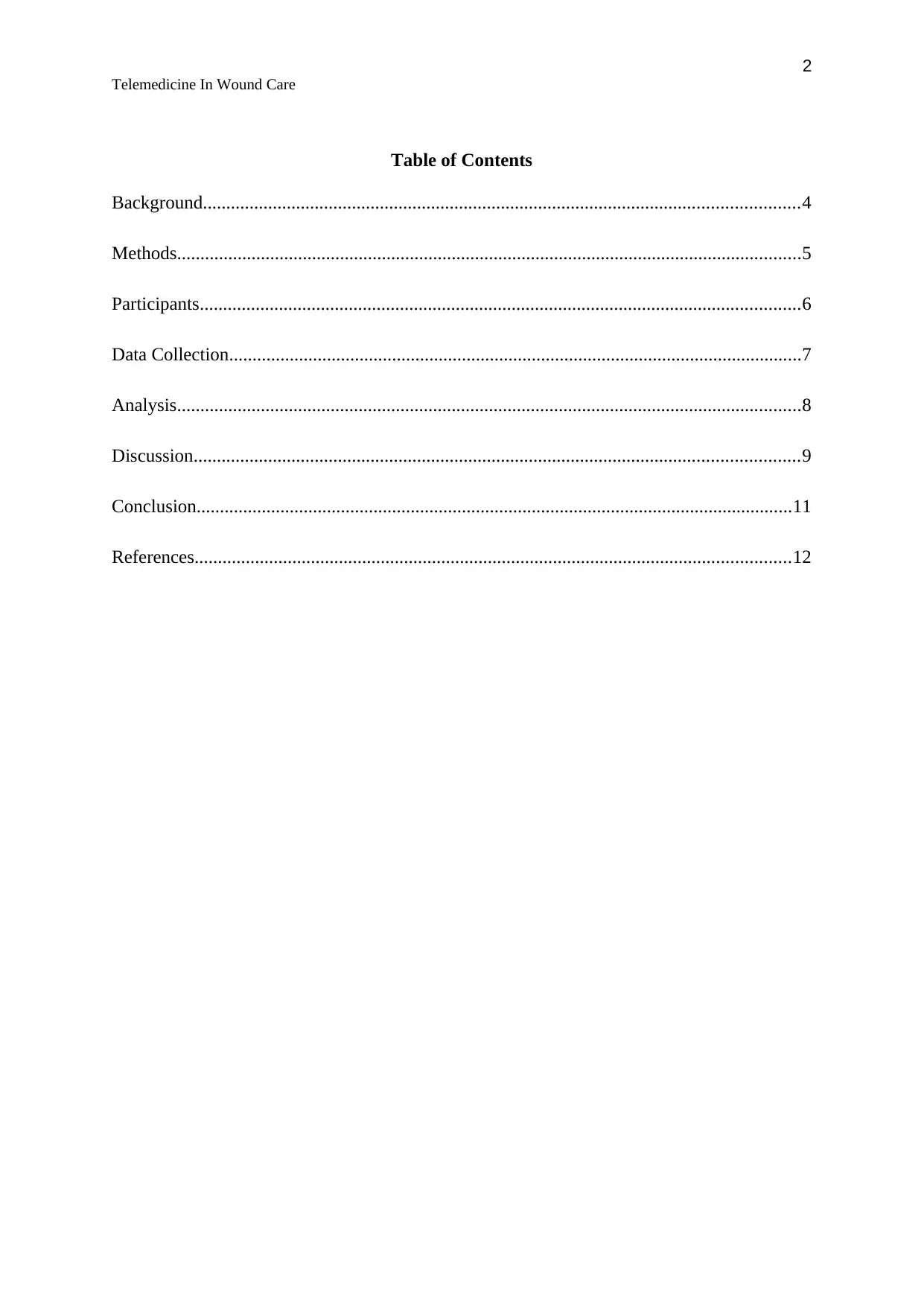
2
Telemedicine In Wound Care
Table of Contents
Background................................................................................................................................4
Methods......................................................................................................................................5
Participants.................................................................................................................................6
Data Collection...........................................................................................................................7
Analysis......................................................................................................................................8
Discussion..................................................................................................................................9
Conclusion................................................................................................................................11
References................................................................................................................................12
Telemedicine In Wound Care
Table of Contents
Background................................................................................................................................4
Methods......................................................................................................................................5
Participants.................................................................................................................................6
Data Collection...........................................................................................................................7
Analysis......................................................................................................................................8
Discussion..................................................................................................................................9
Conclusion................................................................................................................................11
References................................................................................................................................12
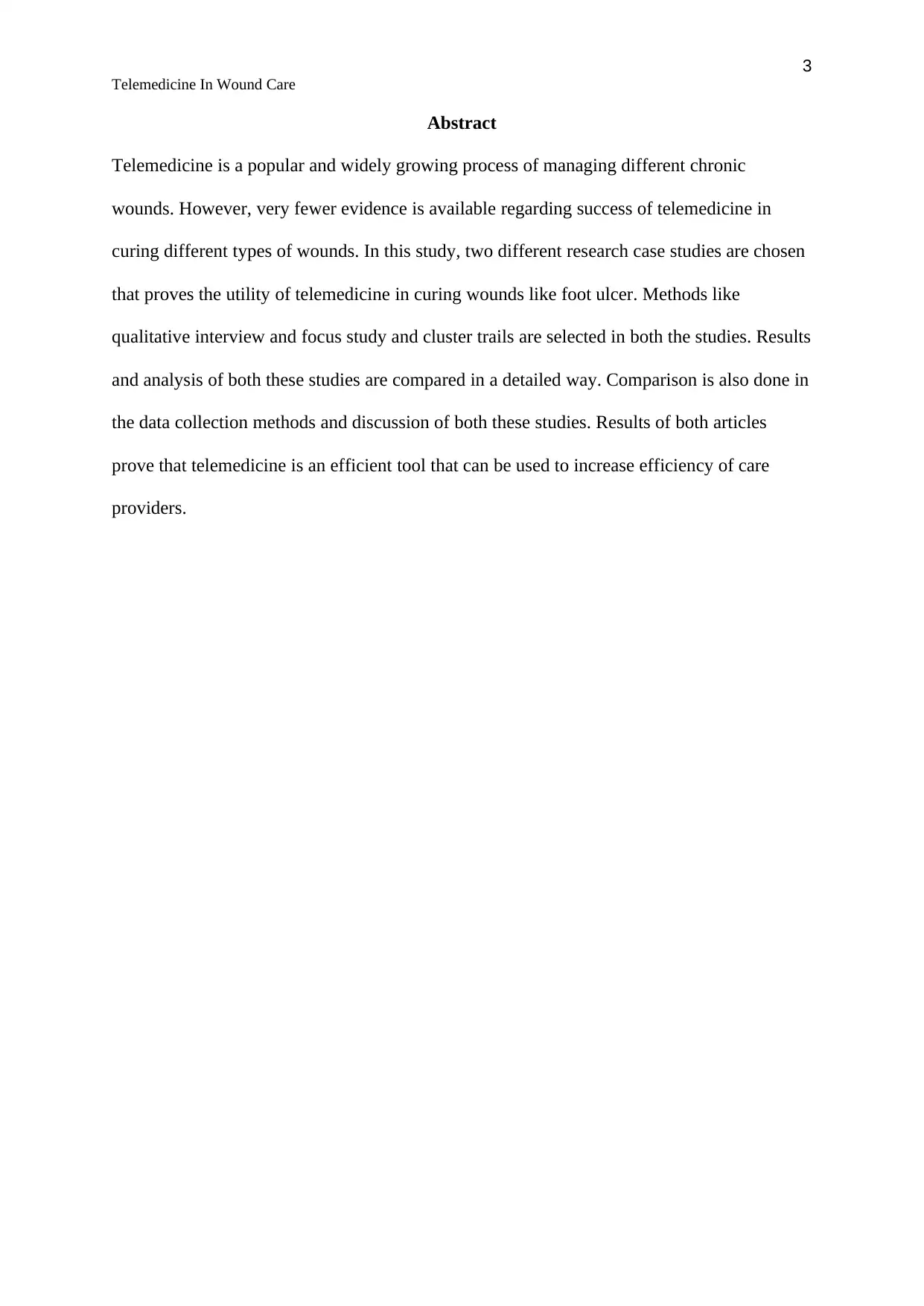
3
Telemedicine In Wound Care
Abstract
Telemedicine is a popular and widely growing process of managing different chronic
wounds. However, very fewer evidence is available regarding success of telemedicine in
curing different types of wounds. In this study, two different research case studies are chosen
that proves the utility of telemedicine in curing wounds like foot ulcer. Methods like
qualitative interview and focus study and cluster trails are selected in both the studies. Results
and analysis of both these studies are compared in a detailed way. Comparison is also done in
the data collection methods and discussion of both these studies. Results of both articles
prove that telemedicine is an efficient tool that can be used to increase efficiency of care
providers.
Telemedicine In Wound Care
Abstract
Telemedicine is a popular and widely growing process of managing different chronic
wounds. However, very fewer evidence is available regarding success of telemedicine in
curing different types of wounds. In this study, two different research case studies are chosen
that proves the utility of telemedicine in curing wounds like foot ulcer. Methods like
qualitative interview and focus study and cluster trails are selected in both the studies. Results
and analysis of both these studies are compared in a detailed way. Comparison is also done in
the data collection methods and discussion of both these studies. Results of both articles
prove that telemedicine is an efficient tool that can be used to increase efficiency of care
providers.
⊘ This is a preview!⊘
Do you want full access?
Subscribe today to unlock all pages.

Trusted by 1+ million students worldwide
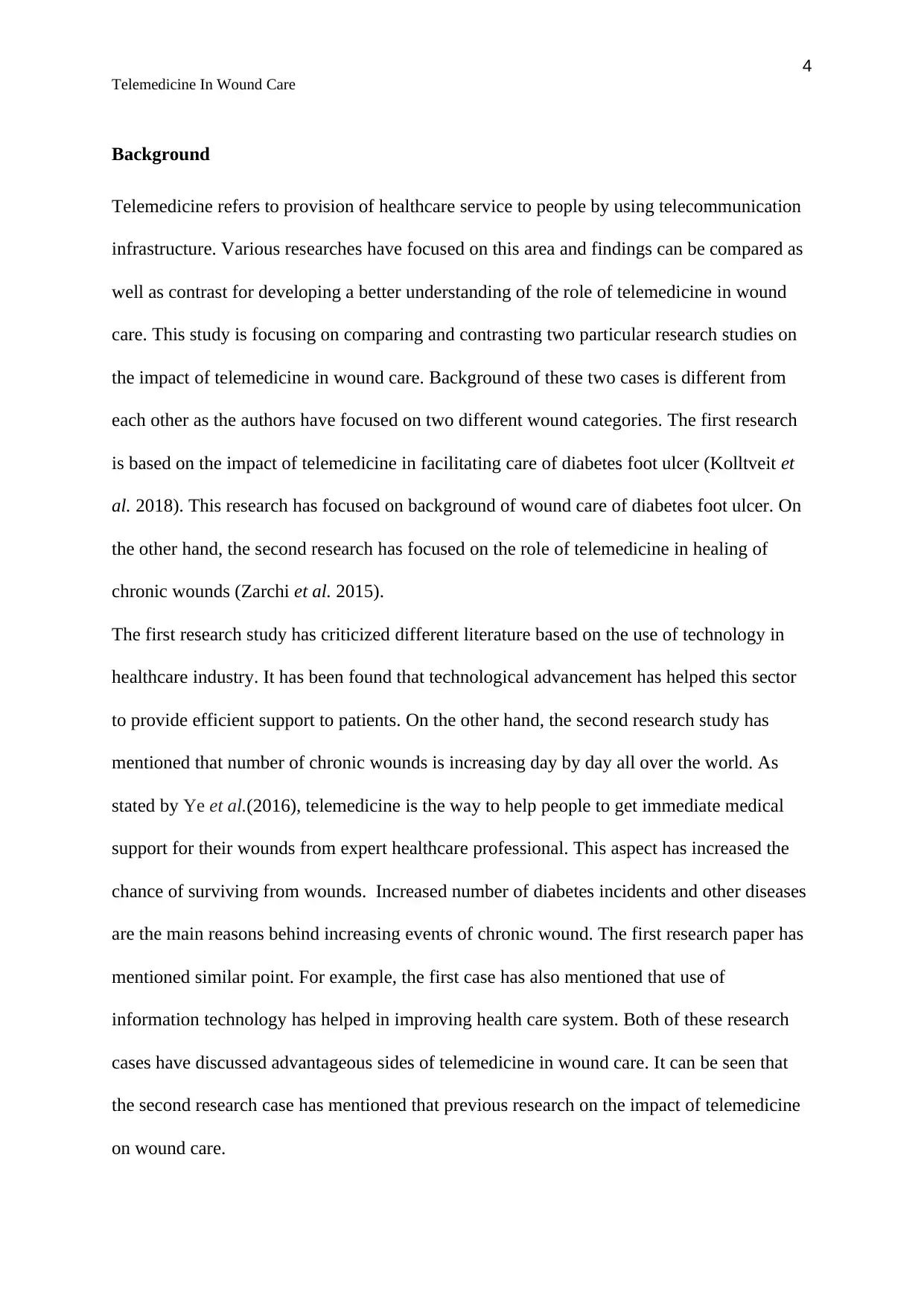
4
Telemedicine In Wound Care
Background
Telemedicine refers to provision of healthcare service to people by using telecommunication
infrastructure. Various researches have focused on this area and findings can be compared as
well as contrast for developing a better understanding of the role of telemedicine in wound
care. This study is focusing on comparing and contrasting two particular research studies on
the impact of telemedicine in wound care. Background of these two cases is different from
each other as the authors have focused on two different wound categories. The first research
is based on the impact of telemedicine in facilitating care of diabetes foot ulcer (Kolltveit et
al. 2018). This research has focused on background of wound care of diabetes foot ulcer. On
the other hand, the second research has focused on the role of telemedicine in healing of
chronic wounds (Zarchi et al. 2015).
The first research study has criticized different literature based on the use of technology in
healthcare industry. It has been found that technological advancement has helped this sector
to provide efficient support to patients. On the other hand, the second research study has
mentioned that number of chronic wounds is increasing day by day all over the world. As
stated by Ye et al.(2016), telemedicine is the way to help people to get immediate medical
support for their wounds from expert healthcare professional. This aspect has increased the
chance of surviving from wounds. Increased number of diabetes incidents and other diseases
are the main reasons behind increasing events of chronic wound. The first research paper has
mentioned similar point. For example, the first case has also mentioned that use of
information technology has helped in improving health care system. Both of these research
cases have discussed advantageous sides of telemedicine in wound care. It can be seen that
the second research case has mentioned that previous research on the impact of telemedicine
on wound care.
Telemedicine In Wound Care
Background
Telemedicine refers to provision of healthcare service to people by using telecommunication
infrastructure. Various researches have focused on this area and findings can be compared as
well as contrast for developing a better understanding of the role of telemedicine in wound
care. This study is focusing on comparing and contrasting two particular research studies on
the impact of telemedicine in wound care. Background of these two cases is different from
each other as the authors have focused on two different wound categories. The first research
is based on the impact of telemedicine in facilitating care of diabetes foot ulcer (Kolltveit et
al. 2018). This research has focused on background of wound care of diabetes foot ulcer. On
the other hand, the second research has focused on the role of telemedicine in healing of
chronic wounds (Zarchi et al. 2015).
The first research study has criticized different literature based on the use of technology in
healthcare industry. It has been found that technological advancement has helped this sector
to provide efficient support to patients. On the other hand, the second research study has
mentioned that number of chronic wounds is increasing day by day all over the world. As
stated by Ye et al.(2016), telemedicine is the way to help people to get immediate medical
support for their wounds from expert healthcare professional. This aspect has increased the
chance of surviving from wounds. Increased number of diabetes incidents and other diseases
are the main reasons behind increasing events of chronic wound. The first research paper has
mentioned similar point. For example, the first case has also mentioned that use of
information technology has helped in improving health care system. Both of these research
cases have discussed advantageous sides of telemedicine in wound care. It can be seen that
the second research case has mentioned that previous research on the impact of telemedicine
on wound care.
Paraphrase This Document
Need a fresh take? Get an instant paraphrase of this document with our AI Paraphraser
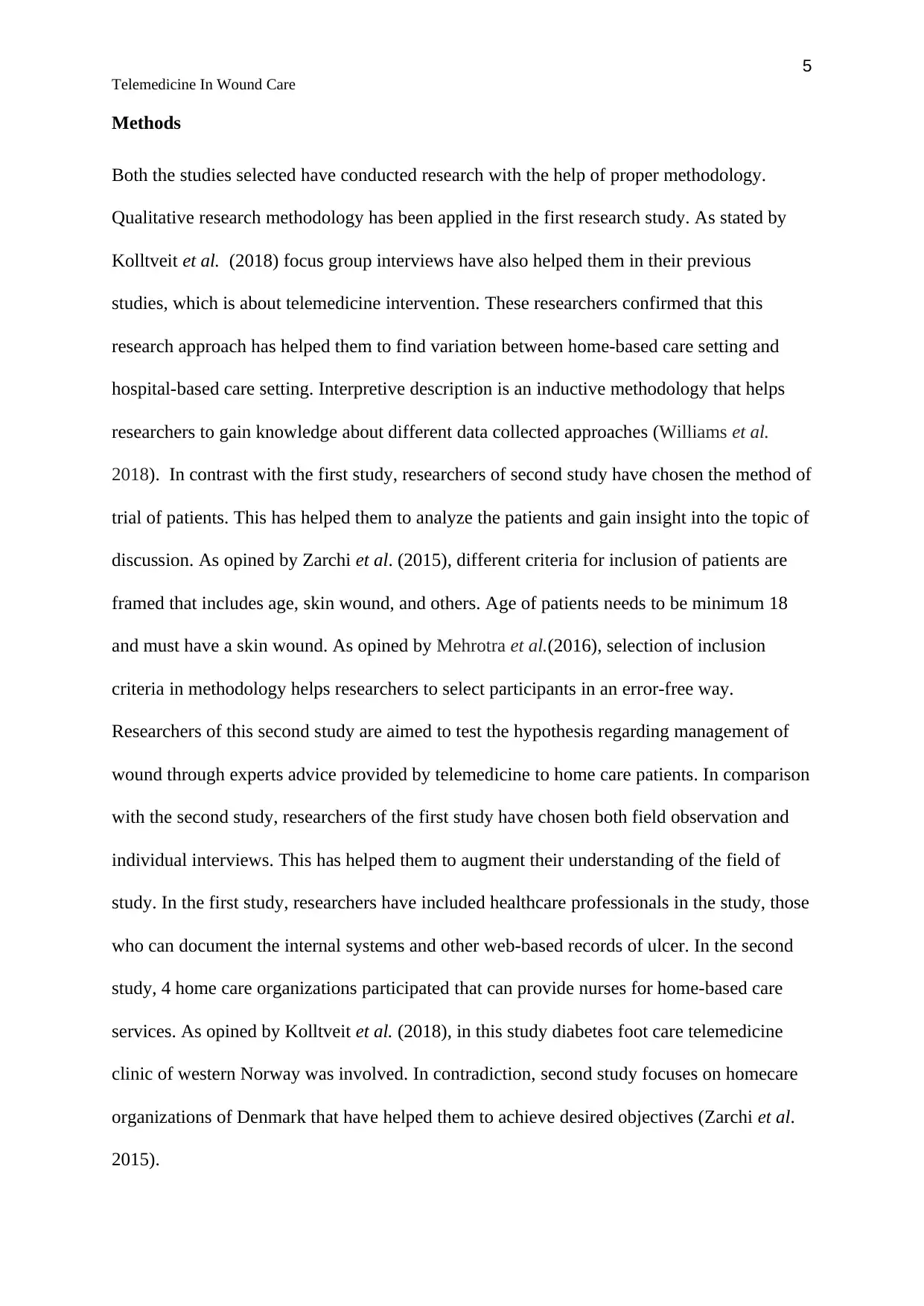
5
Telemedicine In Wound Care
Methods
Both the studies selected have conducted research with the help of proper methodology.
Qualitative research methodology has been applied in the first research study. As stated by
Kolltveit et al. (2018) focus group interviews have also helped them in their previous
studies, which is about telemedicine intervention. These researchers confirmed that this
research approach has helped them to find variation between home-based care setting and
hospital-based care setting. Interpretive description is an inductive methodology that helps
researchers to gain knowledge about different data collected approaches (Williams et al.
2018). In contrast with the first study, researchers of second study have chosen the method of
trial of patients. This has helped them to analyze the patients and gain insight into the topic of
discussion. As opined by Zarchi et al. (2015), different criteria for inclusion of patients are
framed that includes age, skin wound, and others. Age of patients needs to be minimum 18
and must have a skin wound. As opined by Mehrotra et al.(2016), selection of inclusion
criteria in methodology helps researchers to select participants in an error-free way.
Researchers of this second study are aimed to test the hypothesis regarding management of
wound through experts advice provided by telemedicine to home care patients. In comparison
with the second study, researchers of the first study have chosen both field observation and
individual interviews. This has helped them to augment their understanding of the field of
study. In the first study, researchers have included healthcare professionals in the study, those
who can document the internal systems and other web-based records of ulcer. In the second
study, 4 home care organizations participated that can provide nurses for home-based care
services. As opined by Kolltveit et al. (2018), in this study diabetes foot care telemedicine
clinic of western Norway was involved. In contradiction, second study focuses on homecare
organizations of Denmark that have helped them to achieve desired objectives (Zarchi et al.
2015).
Telemedicine In Wound Care
Methods
Both the studies selected have conducted research with the help of proper methodology.
Qualitative research methodology has been applied in the first research study. As stated by
Kolltveit et al. (2018) focus group interviews have also helped them in their previous
studies, which is about telemedicine intervention. These researchers confirmed that this
research approach has helped them to find variation between home-based care setting and
hospital-based care setting. Interpretive description is an inductive methodology that helps
researchers to gain knowledge about different data collected approaches (Williams et al.
2018). In contrast with the first study, researchers of second study have chosen the method of
trial of patients. This has helped them to analyze the patients and gain insight into the topic of
discussion. As opined by Zarchi et al. (2015), different criteria for inclusion of patients are
framed that includes age, skin wound, and others. Age of patients needs to be minimum 18
and must have a skin wound. As opined by Mehrotra et al.(2016), selection of inclusion
criteria in methodology helps researchers to select participants in an error-free way.
Researchers of this second study are aimed to test the hypothesis regarding management of
wound through experts advice provided by telemedicine to home care patients. In comparison
with the second study, researchers of the first study have chosen both field observation and
individual interviews. This has helped them to augment their understanding of the field of
study. In the first study, researchers have included healthcare professionals in the study, those
who can document the internal systems and other web-based records of ulcer. In the second
study, 4 home care organizations participated that can provide nurses for home-based care
services. As opined by Kolltveit et al. (2018), in this study diabetes foot care telemedicine
clinic of western Norway was involved. In contradiction, second study focuses on homecare
organizations of Denmark that have helped them to achieve desired objectives (Zarchi et al.
2015).
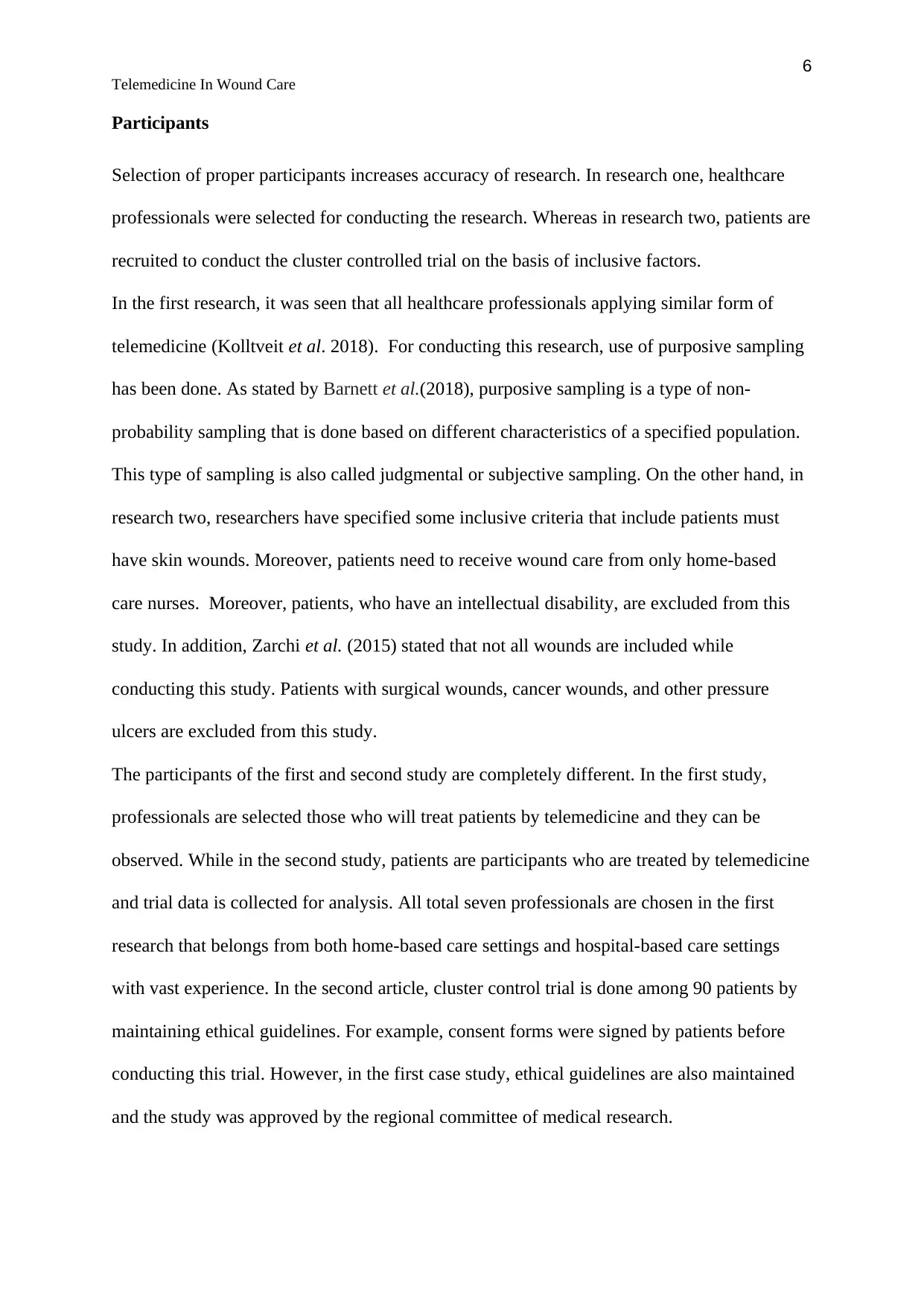
6
Telemedicine In Wound Care
Participants
Selection of proper participants increases accuracy of research. In research one, healthcare
professionals were selected for conducting the research. Whereas in research two, patients are
recruited to conduct the cluster controlled trial on the basis of inclusive factors.
In the first research, it was seen that all healthcare professionals applying similar form of
telemedicine (Kolltveit et al. 2018). For conducting this research, use of purposive sampling
has been done. As stated by Barnett et al.(2018), purposive sampling is a type of non-
probability sampling that is done based on different characteristics of a specified population.
This type of sampling is also called judgmental or subjective sampling. On the other hand, in
research two, researchers have specified some inclusive criteria that include patients must
have skin wounds. Moreover, patients need to receive wound care from only home-based
care nurses. Moreover, patients, who have an intellectual disability, are excluded from this
study. In addition, Zarchi et al. (2015) stated that not all wounds are included while
conducting this study. Patients with surgical wounds, cancer wounds, and other pressure
ulcers are excluded from this study.
The participants of the first and second study are completely different. In the first study,
professionals are selected those who will treat patients by telemedicine and they can be
observed. While in the second study, patients are participants who are treated by telemedicine
and trial data is collected for analysis. All total seven professionals are chosen in the first
research that belongs from both home-based care settings and hospital-based care settings
with vast experience. In the second article, cluster control trial is done among 90 patients by
maintaining ethical guidelines. For example, consent forms were signed by patients before
conducting this trial. However, in the first case study, ethical guidelines are also maintained
and the study was approved by the regional committee of medical research.
Telemedicine In Wound Care
Participants
Selection of proper participants increases accuracy of research. In research one, healthcare
professionals were selected for conducting the research. Whereas in research two, patients are
recruited to conduct the cluster controlled trial on the basis of inclusive factors.
In the first research, it was seen that all healthcare professionals applying similar form of
telemedicine (Kolltveit et al. 2018). For conducting this research, use of purposive sampling
has been done. As stated by Barnett et al.(2018), purposive sampling is a type of non-
probability sampling that is done based on different characteristics of a specified population.
This type of sampling is also called judgmental or subjective sampling. On the other hand, in
research two, researchers have specified some inclusive criteria that include patients must
have skin wounds. Moreover, patients need to receive wound care from only home-based
care nurses. Moreover, patients, who have an intellectual disability, are excluded from this
study. In addition, Zarchi et al. (2015) stated that not all wounds are included while
conducting this study. Patients with surgical wounds, cancer wounds, and other pressure
ulcers are excluded from this study.
The participants of the first and second study are completely different. In the first study,
professionals are selected those who will treat patients by telemedicine and they can be
observed. While in the second study, patients are participants who are treated by telemedicine
and trial data is collected for analysis. All total seven professionals are chosen in the first
research that belongs from both home-based care settings and hospital-based care settings
with vast experience. In the second article, cluster control trial is done among 90 patients by
maintaining ethical guidelines. For example, consent forms were signed by patients before
conducting this trial. However, in the first case study, ethical guidelines are also maintained
and the study was approved by the regional committee of medical research.
⊘ This is a preview!⊘
Do you want full access?
Subscribe today to unlock all pages.

Trusted by 1+ million students worldwide
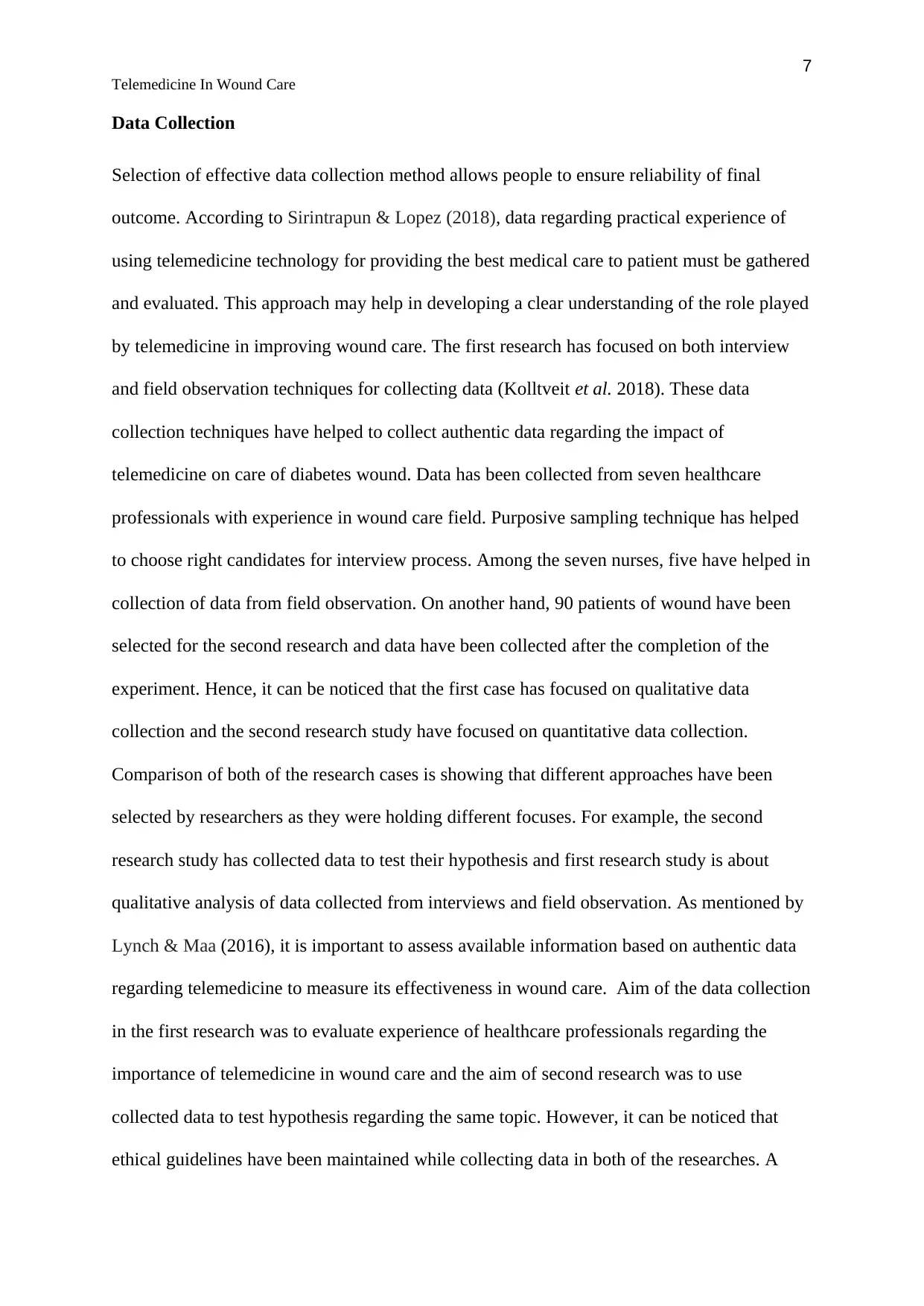
7
Telemedicine In Wound Care
Data Collection
Selection of effective data collection method allows people to ensure reliability of final
outcome. According to Sirintrapun & Lopez (2018), data regarding practical experience of
using telemedicine technology for providing the best medical care to patient must be gathered
and evaluated. This approach may help in developing a clear understanding of the role played
by telemedicine in improving wound care. The first research has focused on both interview
and field observation techniques for collecting data (Kolltveit et al. 2018). These data
collection techniques have helped to collect authentic data regarding the impact of
telemedicine on care of diabetes wound. Data has been collected from seven healthcare
professionals with experience in wound care field. Purposive sampling technique has helped
to choose right candidates for interview process. Among the seven nurses, five have helped in
collection of data from field observation. On another hand, 90 patients of wound have been
selected for the second research and data have been collected after the completion of the
experiment. Hence, it can be noticed that the first case has focused on qualitative data
collection and the second research study have focused on quantitative data collection.
Comparison of both of the research cases is showing that different approaches have been
selected by researchers as they were holding different focuses. For example, the second
research study has collected data to test their hypothesis and first research study is about
qualitative analysis of data collected from interviews and field observation. As mentioned by
Lynch & Maa (2016), it is important to assess available information based on authentic data
regarding telemedicine to measure its effectiveness in wound care. Aim of the data collection
in the first research was to evaluate experience of healthcare professionals regarding the
importance of telemedicine in wound care and the aim of second research was to use
collected data to test hypothesis regarding the same topic. However, it can be noticed that
ethical guidelines have been maintained while collecting data in both of the researches. A
Telemedicine In Wound Care
Data Collection
Selection of effective data collection method allows people to ensure reliability of final
outcome. According to Sirintrapun & Lopez (2018), data regarding practical experience of
using telemedicine technology for providing the best medical care to patient must be gathered
and evaluated. This approach may help in developing a clear understanding of the role played
by telemedicine in improving wound care. The first research has focused on both interview
and field observation techniques for collecting data (Kolltveit et al. 2018). These data
collection techniques have helped to collect authentic data regarding the impact of
telemedicine on care of diabetes wound. Data has been collected from seven healthcare
professionals with experience in wound care field. Purposive sampling technique has helped
to choose right candidates for interview process. Among the seven nurses, five have helped in
collection of data from field observation. On another hand, 90 patients of wound have been
selected for the second research and data have been collected after the completion of the
experiment. Hence, it can be noticed that the first case has focused on qualitative data
collection and the second research study have focused on quantitative data collection.
Comparison of both of the research cases is showing that different approaches have been
selected by researchers as they were holding different focuses. For example, the second
research study has collected data to test their hypothesis and first research study is about
qualitative analysis of data collected from interviews and field observation. As mentioned by
Lynch & Maa (2016), it is important to assess available information based on authentic data
regarding telemedicine to measure its effectiveness in wound care. Aim of the data collection
in the first research was to evaluate experience of healthcare professionals regarding the
importance of telemedicine in wound care and the aim of second research was to use
collected data to test hypothesis regarding the same topic. However, it can be noticed that
ethical guidelines have been maintained while collecting data in both of the researches. A
Paraphrase This Document
Need a fresh take? Get an instant paraphrase of this document with our AI Paraphraser
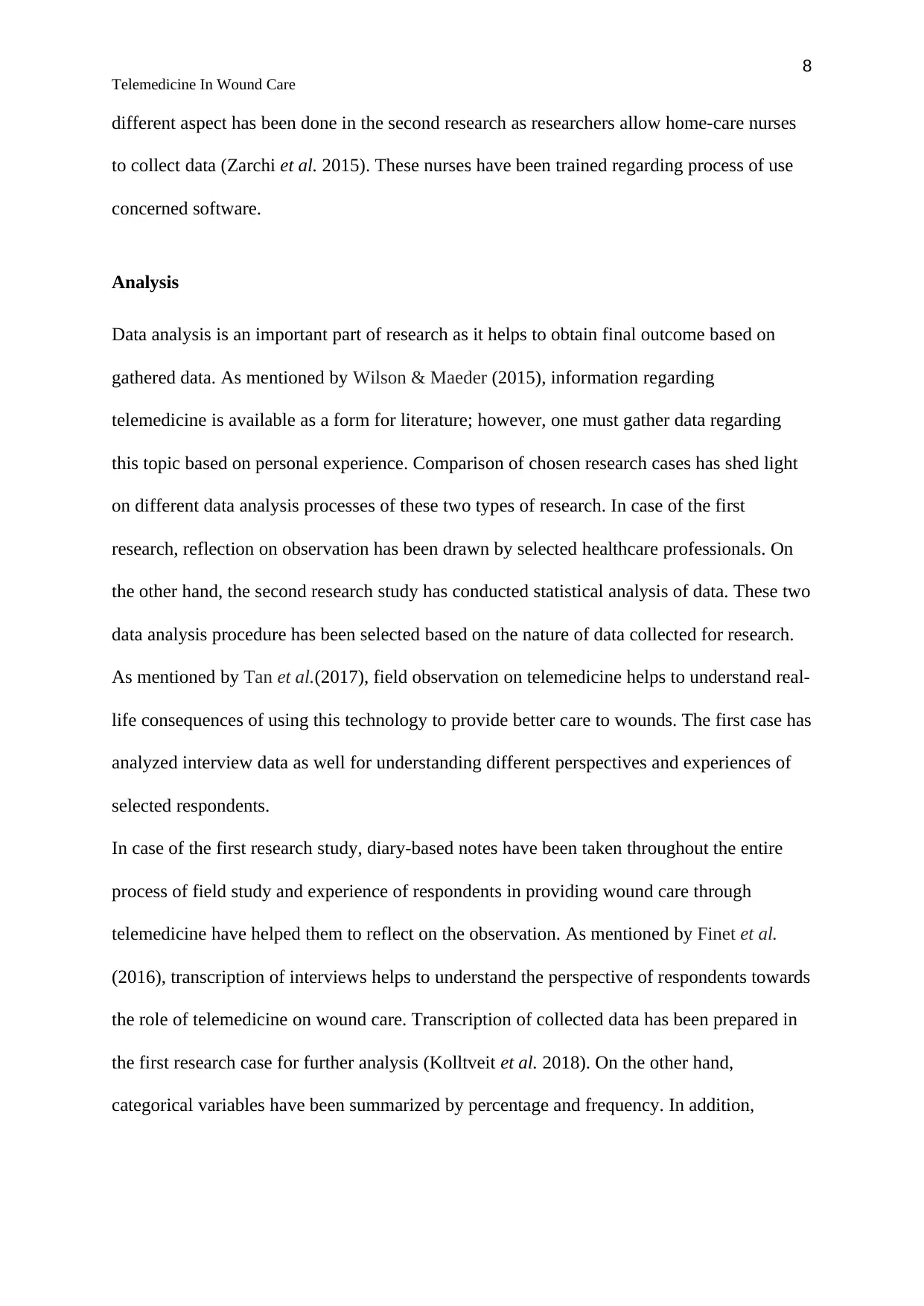
8
Telemedicine In Wound Care
different aspect has been done in the second research as researchers allow home-care nurses
to collect data (Zarchi et al. 2015). These nurses have been trained regarding process of use
concerned software.
Analysis
Data analysis is an important part of research as it helps to obtain final outcome based on
gathered data. As mentioned by Wilson & Maeder (2015), information regarding
telemedicine is available as a form for literature; however, one must gather data regarding
this topic based on personal experience. Comparison of chosen research cases has shed light
on different data analysis processes of these two types of research. In case of the first
research, reflection on observation has been drawn by selected healthcare professionals. On
the other hand, the second research study has conducted statistical analysis of data. These two
data analysis procedure has been selected based on the nature of data collected for research.
As mentioned by Tan et al.(2017), field observation on telemedicine helps to understand real-
life consequences of using this technology to provide better care to wounds. The first case has
analyzed interview data as well for understanding different perspectives and experiences of
selected respondents.
In case of the first research study, diary-based notes have been taken throughout the entire
process of field study and experience of respondents in providing wound care through
telemedicine have helped them to reflect on the observation. As mentioned by Finet et al.
(2016), transcription of interviews helps to understand the perspective of respondents towards
the role of telemedicine on wound care. Transcription of collected data has been prepared in
the first research case for further analysis (Kolltveit et al. 2018). On the other hand,
categorical variables have been summarized by percentage and frequency. In addition,
Telemedicine In Wound Care
different aspect has been done in the second research as researchers allow home-care nurses
to collect data (Zarchi et al. 2015). These nurses have been trained regarding process of use
concerned software.
Analysis
Data analysis is an important part of research as it helps to obtain final outcome based on
gathered data. As mentioned by Wilson & Maeder (2015), information regarding
telemedicine is available as a form for literature; however, one must gather data regarding
this topic based on personal experience. Comparison of chosen research cases has shed light
on different data analysis processes of these two types of research. In case of the first
research, reflection on observation has been drawn by selected healthcare professionals. On
the other hand, the second research study has conducted statistical analysis of data. These two
data analysis procedure has been selected based on the nature of data collected for research.
As mentioned by Tan et al.(2017), field observation on telemedicine helps to understand real-
life consequences of using this technology to provide better care to wounds. The first case has
analyzed interview data as well for understanding different perspectives and experiences of
selected respondents.
In case of the first research study, diary-based notes have been taken throughout the entire
process of field study and experience of respondents in providing wound care through
telemedicine have helped them to reflect on the observation. As mentioned by Finet et al.
(2016), transcription of interviews helps to understand the perspective of respondents towards
the role of telemedicine on wound care. Transcription of collected data has been prepared in
the first research case for further analysis (Kolltveit et al. 2018). On the other hand,
categorical variables have been summarized by percentage and frequency. In addition,
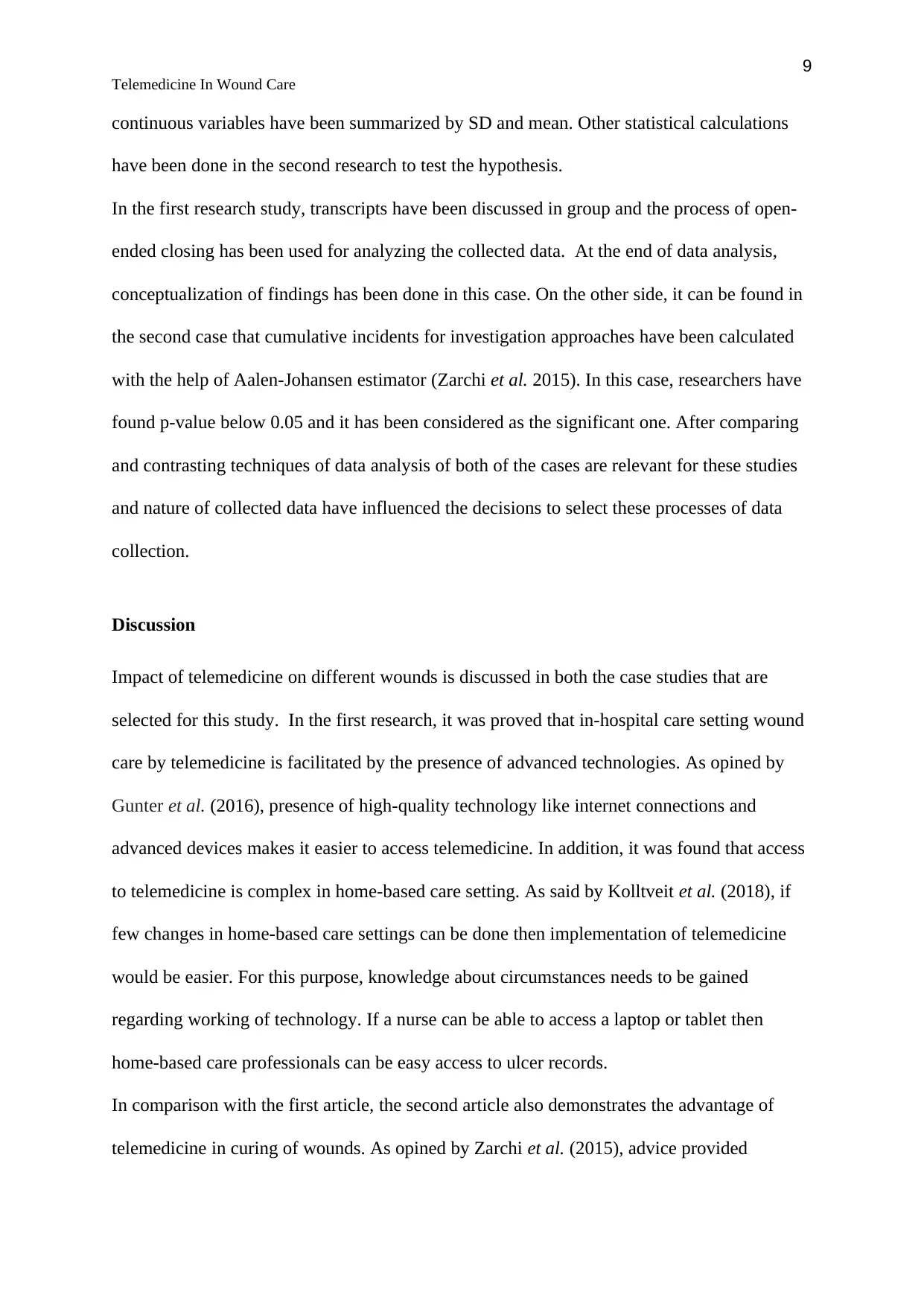
9
Telemedicine In Wound Care
continuous variables have been summarized by SD and mean. Other statistical calculations
have been done in the second research to test the hypothesis.
In the first research study, transcripts have been discussed in group and the process of open-
ended closing has been used for analyzing the collected data. At the end of data analysis,
conceptualization of findings has been done in this case. On the other side, it can be found in
the second case that cumulative incidents for investigation approaches have been calculated
with the help of Aalen-Johansen estimator (Zarchi et al. 2015). In this case, researchers have
found p-value below 0.05 and it has been considered as the significant one. After comparing
and contrasting techniques of data analysis of both of the cases are relevant for these studies
and nature of collected data have influenced the decisions to select these processes of data
collection.
Discussion
Impact of telemedicine on different wounds is discussed in both the case studies that are
selected for this study. In the first research, it was proved that in-hospital care setting wound
care by telemedicine is facilitated by the presence of advanced technologies. As opined by
Gunter et al. (2016), presence of high-quality technology like internet connections and
advanced devices makes it easier to access telemedicine. In addition, it was found that access
to telemedicine is complex in home-based care setting. As said by Kolltveit et al. (2018), if
few changes in home-based care settings can be done then implementation of telemedicine
would be easier. For this purpose, knowledge about circumstances needs to be gained
regarding working of technology. If a nurse can be able to access a laptop or tablet then
home-based care professionals can be easy access to ulcer records.
In comparison with the first article, the second article also demonstrates the advantage of
telemedicine in curing of wounds. As opined by Zarchi et al. (2015), advice provided
Telemedicine In Wound Care
continuous variables have been summarized by SD and mean. Other statistical calculations
have been done in the second research to test the hypothesis.
In the first research study, transcripts have been discussed in group and the process of open-
ended closing has been used for analyzing the collected data. At the end of data analysis,
conceptualization of findings has been done in this case. On the other side, it can be found in
the second case that cumulative incidents for investigation approaches have been calculated
with the help of Aalen-Johansen estimator (Zarchi et al. 2015). In this case, researchers have
found p-value below 0.05 and it has been considered as the significant one. After comparing
and contrasting techniques of data analysis of both of the cases are relevant for these studies
and nature of collected data have influenced the decisions to select these processes of data
collection.
Discussion
Impact of telemedicine on different wounds is discussed in both the case studies that are
selected for this study. In the first research, it was proved that in-hospital care setting wound
care by telemedicine is facilitated by the presence of advanced technologies. As opined by
Gunter et al. (2016), presence of high-quality technology like internet connections and
advanced devices makes it easier to access telemedicine. In addition, it was found that access
to telemedicine is complex in home-based care setting. As said by Kolltveit et al. (2018), if
few changes in home-based care settings can be done then implementation of telemedicine
would be easier. For this purpose, knowledge about circumstances needs to be gained
regarding working of technology. If a nurse can be able to access a laptop or tablet then
home-based care professionals can be easy access to ulcer records.
In comparison with the first article, the second article also demonstrates the advantage of
telemedicine in curing of wounds. As opined by Zarchi et al. (2015), advice provided
⊘ This is a preview!⊘
Do you want full access?
Subscribe today to unlock all pages.

Trusted by 1+ million students worldwide
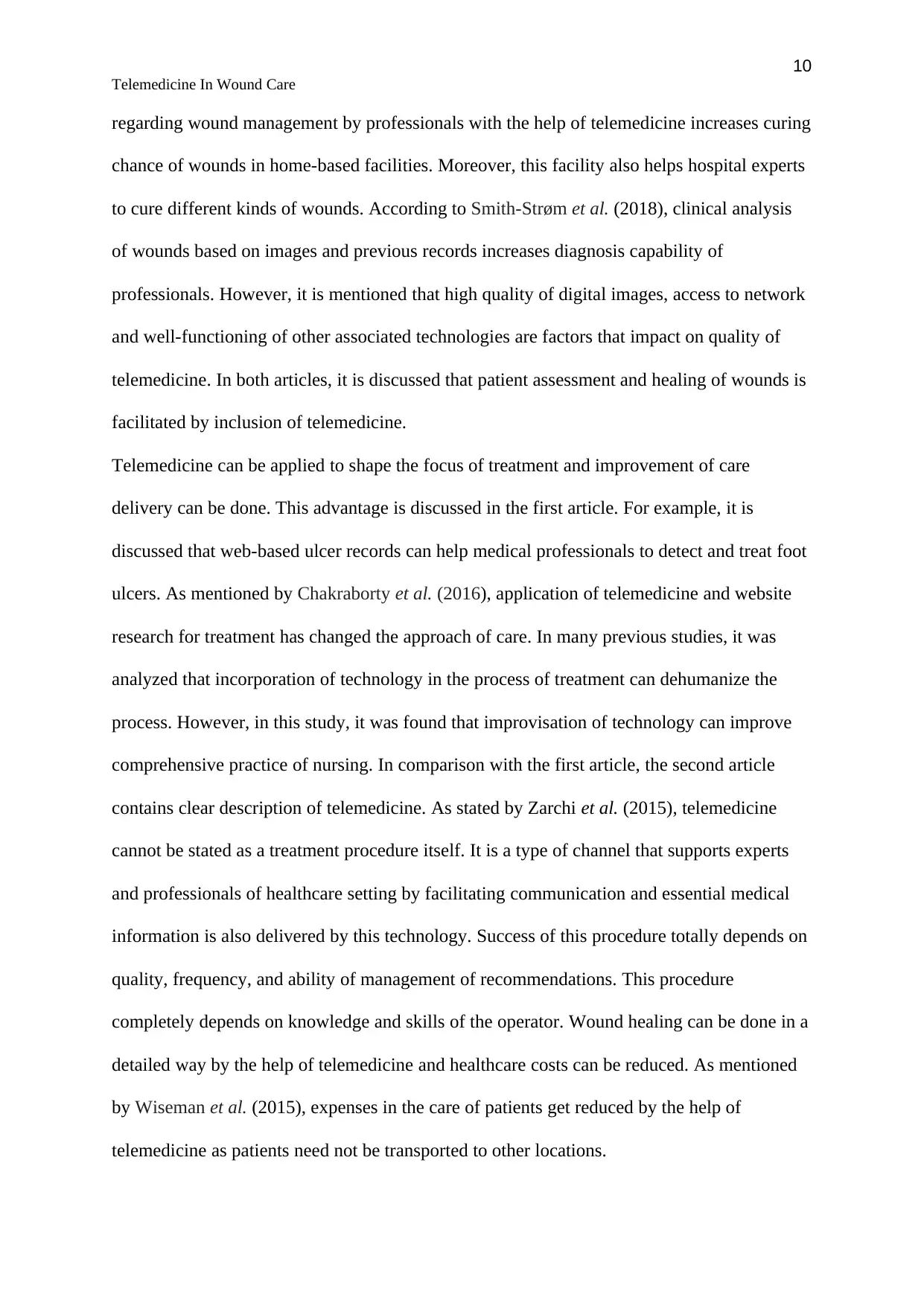
10
Telemedicine In Wound Care
regarding wound management by professionals with the help of telemedicine increases curing
chance of wounds in home-based facilities. Moreover, this facility also helps hospital experts
to cure different kinds of wounds. According to Smith-Strøm et al. (2018), clinical analysis
of wounds based on images and previous records increases diagnosis capability of
professionals. However, it is mentioned that high quality of digital images, access to network
and well-functioning of other associated technologies are factors that impact on quality of
telemedicine. In both articles, it is discussed that patient assessment and healing of wounds is
facilitated by inclusion of telemedicine.
Telemedicine can be applied to shape the focus of treatment and improvement of care
delivery can be done. This advantage is discussed in the first article. For example, it is
discussed that web-based ulcer records can help medical professionals to detect and treat foot
ulcers. As mentioned by Chakraborty et al. (2016), application of telemedicine and website
research for treatment has changed the approach of care. In many previous studies, it was
analyzed that incorporation of technology in the process of treatment can dehumanize the
process. However, in this study, it was found that improvisation of technology can improve
comprehensive practice of nursing. In comparison with the first article, the second article
contains clear description of telemedicine. As stated by Zarchi et al. (2015), telemedicine
cannot be stated as a treatment procedure itself. It is a type of channel that supports experts
and professionals of healthcare setting by facilitating communication and essential medical
information is also delivered by this technology. Success of this procedure totally depends on
quality, frequency, and ability of management of recommendations. This procedure
completely depends on knowledge and skills of the operator. Wound healing can be done in a
detailed way by the help of telemedicine and healthcare costs can be reduced. As mentioned
by Wiseman et al. (2015), expenses in the care of patients get reduced by the help of
telemedicine as patients need not be transported to other locations.
Telemedicine In Wound Care
regarding wound management by professionals with the help of telemedicine increases curing
chance of wounds in home-based facilities. Moreover, this facility also helps hospital experts
to cure different kinds of wounds. According to Smith-Strøm et al. (2018), clinical analysis
of wounds based on images and previous records increases diagnosis capability of
professionals. However, it is mentioned that high quality of digital images, access to network
and well-functioning of other associated technologies are factors that impact on quality of
telemedicine. In both articles, it is discussed that patient assessment and healing of wounds is
facilitated by inclusion of telemedicine.
Telemedicine can be applied to shape the focus of treatment and improvement of care
delivery can be done. This advantage is discussed in the first article. For example, it is
discussed that web-based ulcer records can help medical professionals to detect and treat foot
ulcers. As mentioned by Chakraborty et al. (2016), application of telemedicine and website
research for treatment has changed the approach of care. In many previous studies, it was
analyzed that incorporation of technology in the process of treatment can dehumanize the
process. However, in this study, it was found that improvisation of technology can improve
comprehensive practice of nursing. In comparison with the first article, the second article
contains clear description of telemedicine. As stated by Zarchi et al. (2015), telemedicine
cannot be stated as a treatment procedure itself. It is a type of channel that supports experts
and professionals of healthcare setting by facilitating communication and essential medical
information is also delivered by this technology. Success of this procedure totally depends on
quality, frequency, and ability of management of recommendations. This procedure
completely depends on knowledge and skills of the operator. Wound healing can be done in a
detailed way by the help of telemedicine and healthcare costs can be reduced. As mentioned
by Wiseman et al. (2015), expenses in the care of patients get reduced by the help of
telemedicine as patients need not be transported to other locations.
Paraphrase This Document
Need a fresh take? Get an instant paraphrase of this document with our AI Paraphraser
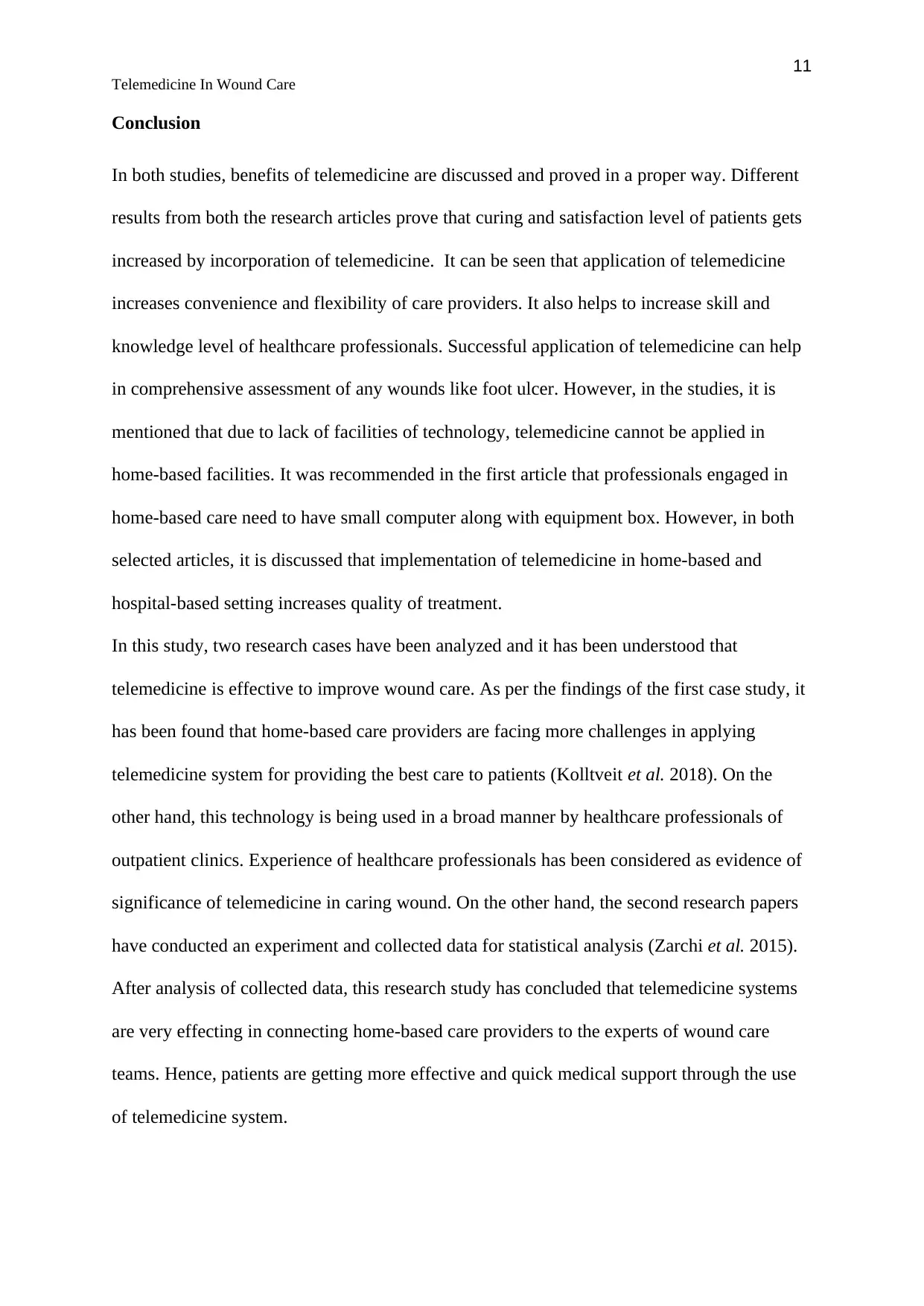
11
Telemedicine In Wound Care
Conclusion
In both studies, benefits of telemedicine are discussed and proved in a proper way. Different
results from both the research articles prove that curing and satisfaction level of patients gets
increased by incorporation of telemedicine. It can be seen that application of telemedicine
increases convenience and flexibility of care providers. It also helps to increase skill and
knowledge level of healthcare professionals. Successful application of telemedicine can help
in comprehensive assessment of any wounds like foot ulcer. However, in the studies, it is
mentioned that due to lack of facilities of technology, telemedicine cannot be applied in
home-based facilities. It was recommended in the first article that professionals engaged in
home-based care need to have small computer along with equipment box. However, in both
selected articles, it is discussed that implementation of telemedicine in home-based and
hospital-based setting increases quality of treatment.
In this study, two research cases have been analyzed and it has been understood that
telemedicine is effective to improve wound care. As per the findings of the first case study, it
has been found that home-based care providers are facing more challenges in applying
telemedicine system for providing the best care to patients (Kolltveit et al. 2018). On the
other hand, this technology is being used in a broad manner by healthcare professionals of
outpatient clinics. Experience of healthcare professionals has been considered as evidence of
significance of telemedicine in caring wound. On the other hand, the second research papers
have conducted an experiment and collected data for statistical analysis (Zarchi et al. 2015).
After analysis of collected data, this research study has concluded that telemedicine systems
are very effecting in connecting home-based care providers to the experts of wound care
teams. Hence, patients are getting more effective and quick medical support through the use
of telemedicine system.
Telemedicine In Wound Care
Conclusion
In both studies, benefits of telemedicine are discussed and proved in a proper way. Different
results from both the research articles prove that curing and satisfaction level of patients gets
increased by incorporation of telemedicine. It can be seen that application of telemedicine
increases convenience and flexibility of care providers. It also helps to increase skill and
knowledge level of healthcare professionals. Successful application of telemedicine can help
in comprehensive assessment of any wounds like foot ulcer. However, in the studies, it is
mentioned that due to lack of facilities of technology, telemedicine cannot be applied in
home-based facilities. It was recommended in the first article that professionals engaged in
home-based care need to have small computer along with equipment box. However, in both
selected articles, it is discussed that implementation of telemedicine in home-based and
hospital-based setting increases quality of treatment.
In this study, two research cases have been analyzed and it has been understood that
telemedicine is effective to improve wound care. As per the findings of the first case study, it
has been found that home-based care providers are facing more challenges in applying
telemedicine system for providing the best care to patients (Kolltveit et al. 2018). On the
other hand, this technology is being used in a broad manner by healthcare professionals of
outpatient clinics. Experience of healthcare professionals has been considered as evidence of
significance of telemedicine in caring wound. On the other hand, the second research papers
have conducted an experiment and collected data for statistical analysis (Zarchi et al. 2015).
After analysis of collected data, this research study has concluded that telemedicine systems
are very effecting in connecting home-based care providers to the experts of wound care
teams. Hence, patients are getting more effective and quick medical support through the use
of telemedicine system.
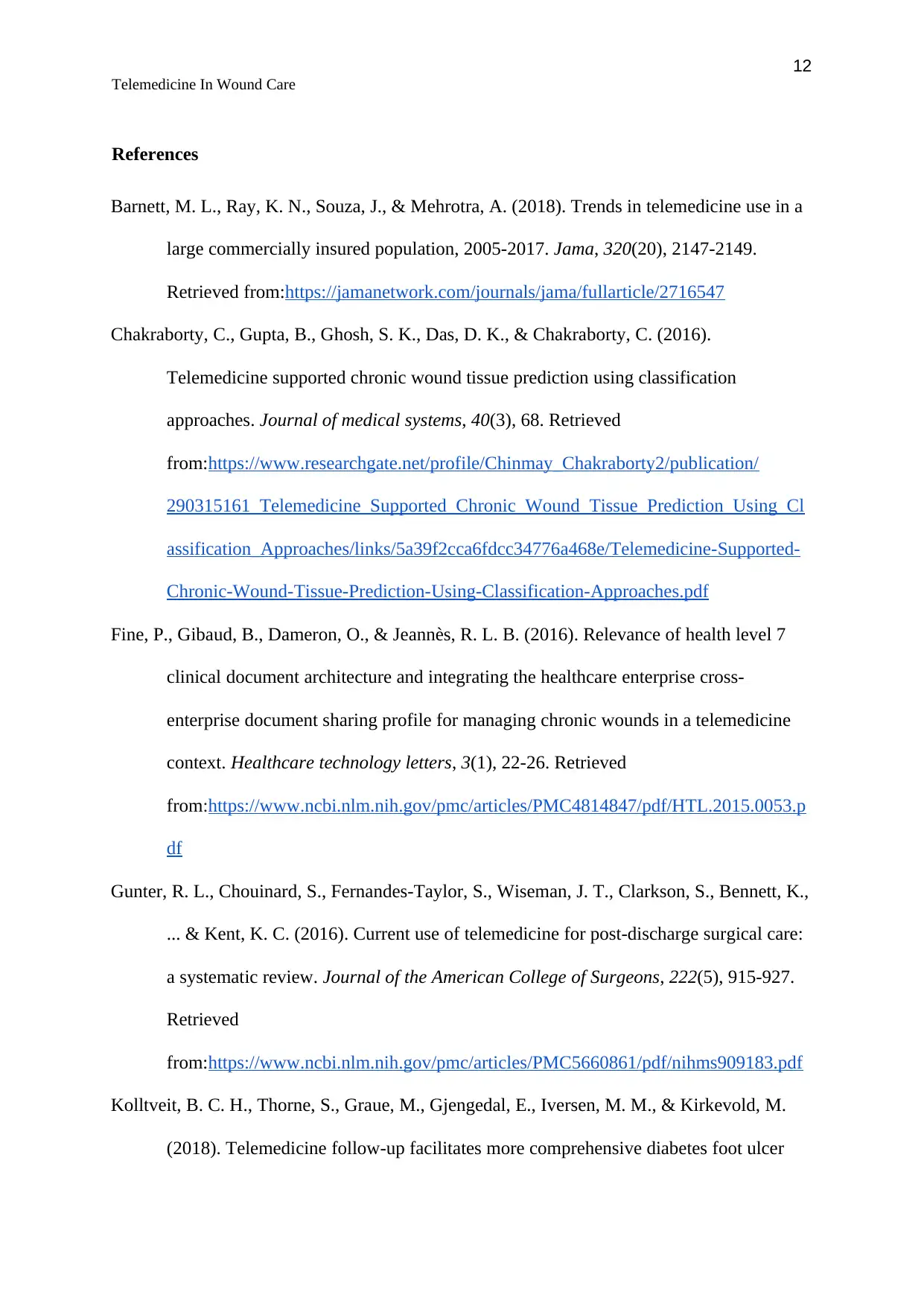
12
Telemedicine In Wound Care
References
Barnett, M. L., Ray, K. N., Souza, J., & Mehrotra, A. (2018). Trends in telemedicine use in a
large commercially insured population, 2005-2017. Jama, 320(20), 2147-2149.
Retrieved from:https://jamanetwork.com/journals/jama/fullarticle/2716547
Chakraborty, C., Gupta, B., Ghosh, S. K., Das, D. K., & Chakraborty, C. (2016).
Telemedicine supported chronic wound tissue prediction using classification
approaches. Journal of medical systems, 40(3), 68. Retrieved
from:https://www.researchgate.net/profile/Chinmay_Chakraborty2/publication/
290315161_Telemedicine_Supported_Chronic_Wound_Tissue_Prediction_Using_Cl
assification_Approaches/links/5a39f2cca6fdcc34776a468e/Telemedicine-Supported-
Chronic-Wound-Tissue-Prediction-Using-Classification-Approaches.pdf
Fine, P., Gibaud, B., Dameron, O., & Jeannès, R. L. B. (2016). Relevance of health level 7
clinical document architecture and integrating the healthcare enterprise cross-
enterprise document sharing profile for managing chronic wounds in a telemedicine
context. Healthcare technology letters, 3(1), 22-26. Retrieved
from:https://www.ncbi.nlm.nih.gov/pmc/articles/PMC4814847/pdf/HTL.2015.0053.p
df
Gunter, R. L., Chouinard, S., Fernandes-Taylor, S., Wiseman, J. T., Clarkson, S., Bennett, K.,
... & Kent, K. C. (2016). Current use of telemedicine for post-discharge surgical care:
a systematic review. Journal of the American College of Surgeons, 222(5), 915-927.
Retrieved
from:https://www.ncbi.nlm.nih.gov/pmc/articles/PMC5660861/pdf/nihms909183.pdf
Kolltveit, B. C. H., Thorne, S., Graue, M., Gjengedal, E., Iversen, M. M., & Kirkevold, M.
(2018). Telemedicine follow‐up facilitates more comprehensive diabetes foot ulcer
Telemedicine In Wound Care
References
Barnett, M. L., Ray, K. N., Souza, J., & Mehrotra, A. (2018). Trends in telemedicine use in a
large commercially insured population, 2005-2017. Jama, 320(20), 2147-2149.
Retrieved from:https://jamanetwork.com/journals/jama/fullarticle/2716547
Chakraborty, C., Gupta, B., Ghosh, S. K., Das, D. K., & Chakraborty, C. (2016).
Telemedicine supported chronic wound tissue prediction using classification
approaches. Journal of medical systems, 40(3), 68. Retrieved
from:https://www.researchgate.net/profile/Chinmay_Chakraborty2/publication/
290315161_Telemedicine_Supported_Chronic_Wound_Tissue_Prediction_Using_Cl
assification_Approaches/links/5a39f2cca6fdcc34776a468e/Telemedicine-Supported-
Chronic-Wound-Tissue-Prediction-Using-Classification-Approaches.pdf
Fine, P., Gibaud, B., Dameron, O., & Jeannès, R. L. B. (2016). Relevance of health level 7
clinical document architecture and integrating the healthcare enterprise cross-
enterprise document sharing profile for managing chronic wounds in a telemedicine
context. Healthcare technology letters, 3(1), 22-26. Retrieved
from:https://www.ncbi.nlm.nih.gov/pmc/articles/PMC4814847/pdf/HTL.2015.0053.p
df
Gunter, R. L., Chouinard, S., Fernandes-Taylor, S., Wiseman, J. T., Clarkson, S., Bennett, K.,
... & Kent, K. C. (2016). Current use of telemedicine for post-discharge surgical care:
a systematic review. Journal of the American College of Surgeons, 222(5), 915-927.
Retrieved
from:https://www.ncbi.nlm.nih.gov/pmc/articles/PMC5660861/pdf/nihms909183.pdf
Kolltveit, B. C. H., Thorne, S., Graue, M., Gjengedal, E., Iversen, M. M., & Kirkevold, M.
(2018). Telemedicine follow‐up facilitates more comprehensive diabetes foot ulcer
⊘ This is a preview!⊘
Do you want full access?
Subscribe today to unlock all pages.

Trusted by 1+ million students worldwide
1 out of 15
Related Documents
Your All-in-One AI-Powered Toolkit for Academic Success.
+13062052269
info@desklib.com
Available 24*7 on WhatsApp / Email
![[object Object]](/_next/static/media/star-bottom.7253800d.svg)
Unlock your academic potential
Copyright © 2020–2025 A2Z Services. All Rights Reserved. Developed and managed by ZUCOL.





